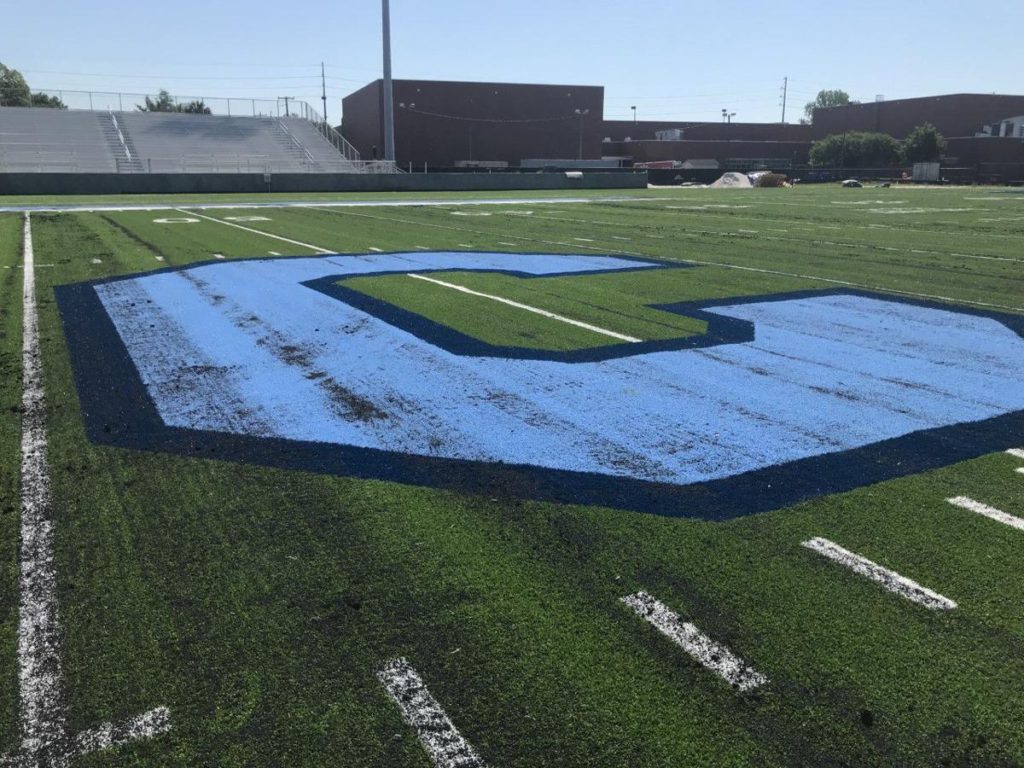
Black rubber infill on the new synthetic turf at The Citadel’s Johnson Hagood Stadium will help cool the playing surface by up to 50 degrees. Jeff Hartsell/Staff
Just off the new synthetic turf at The Citadel’s Johnson Hagood Stadium, a small crane hoists a heavy white bag and lifts it high over a bin.
A worker armed with a curved blade at the top of a pole slashes open the bottom of the bag, and 2,000 pounds of black rubber pellets cascade into the bin, which is attached to a tractor. As the tractor pulls the bin back and forth across the turf, a black curtain of rubber falls onto the green field.
Over the past couple of days, 95 bags of the black rubber infill — some 190,000 pounds — and about 270,000 pounds of sand have been distributed across the new SporTurf surface at The Citadel’s football stadium, part of a $1.5 million project to replace the historic stadium’s grass field.
The infill helps to give the turf weight and balance, but there is something different about these black rubber pellets — they can help cool the surface temperature of the synthetic turf by between 30 and 50 degrees.
The Citadel is the first NCAA Division I school to use the new technology, which is made by T°Cool, the company said. It has been installed at about 10 high schools across the Carolinas.
The black rubber pellets are encapsulated with a polymer that absorbs moisture and then releases it over time, creating a cooling affect on the synthetic turf, which can get hotter than a normal grass field.
“The technology is the same as you’d find in a baby’s diaper,” said T°Cool’s Rick Oleksyk, who was at the stadium on Monday to oversee the process. “The baby wets his diaper and cries, then all of a sudden he’s fine and the diaper is dry. What happens is that this material absorbs the moisture, just like when you go to change a diaper and it feels heavy.
“The same thing happens with this. It stores moisture, and as it gets hotter it releases the moisture and creates a cooling affect.”
On synthetic surfaces that reach up to 150 degrees on a hot day, the difference can be significant.
“If you stood in one spot that was untreated and another one that was treated, you’d feel the difference,” Oleksyk said.
The fibers used on synthetic fields do not absorb moisture as readily as real grass, which is why they can get hotter than grass fields — up to 50 degrees hotter, according to a study by Penn State’s Center for Sports Surface Research.
Those higher temperatures can lead to a greater chance of heat-related issues such as discomfort, dehydration and heat stroke, the study said.
“The majority of turf such as this is made of polyethylene, and those fibers are not treated to absorb any kind of moisture,” Oleksyk said. “There are incredible benefits to synthetic turf, but one of the drawbacks is that it will get hotter than real grass.”
The Citadel’s new field has an irrigation system that can be used to wet the infill if necessary.
“What powers the system is moisture — rain, irrigation or dew in the morning,”
Oleksyk said. “But what extends how well it cools is humidity. Once you get above 35 percent humidity, that will help extend how long it cools without depleting the pellets.”
The pellets are completely safe, Oleksyk said, and won’t be obviously visible on game day.
“The turf The Citadel has installed is a phenomenal product,” Oleksyk said. “They did a mix of fibers and the way it is constructed, you will always have a little ‘splash’ where the material comes up. But it’s going to be a lot less on this than on your average field.”
